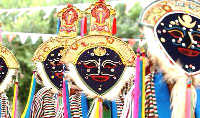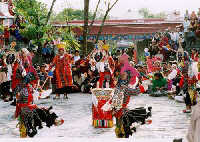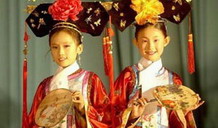Tibetan Opera: 'Living Fossil' of Tibetan Culture
The Xangba School from western Tibet combines the influence of local folklore and the Gyanggar School.
4. The Gyormolung School
The Gyormolung School from the Shannan and Lhasa areas is the most recently established school. Specializing in singing, choreography, stunts, and comic effects, it is the most developed among the four schools and has formed a jubilant style with rich and colorful songs and dances. Today, Gyormolung troupes are active in different parts of Tibet and are even known in Sichuan Province's Garze region as well as the Southeast Asian countries of India and Bhutan.
Tibetan Opera reflects the Tibetan people's lives from various periods. The original scripts from which the opera was adapted have remained popular readings among Tibetans for centuries. Currently there are about 20 traditional repertoires (although some of the scripts have been lost and only the names and some of the plots remain).
The famous Eight Great Classical Tibetan Operas include Prince Nor-bzang, Maiden Vgro-ba-bzang-mo, Brothers Don-yod and Don-grub, Prince Dri-med-Kun-idan, Princess Wencheng, Gzugs-kyi-nyi-ma, Pad-ma-vod-vba, and Maiden Shang-sa -- most of which were derived from historic events, famous lives, folk tales, and stories from the sutras.
 Rebirth of the legendary opera
Rebirth of the legendary opera
Throughout the ages Tibetan Opera has played a central role in the life of the Tibetan people. It features prominently in a number of Tibetan festivals and temple fairs, some of which are specifically designed for it, such as the Shoton Festival (also known as Yoghurt Festival). By the 19th century most districts in Tibet had their own opera troupes.
The opera spread from Shannan, Xigaze, and Lhasa to other parts of Tibet, and further into Southwest China's Sichuan and Yunnan provinces, Northwest China's Qinghai and Gansu provinces, and the neighboring countries of India, Bhutan, and Nepal.
However, Tibetan Opera, boasting the longest history among the few other folk operas of Chinese ethnic minorities, was once on the verge of fading away in the 20th century like many other traditional folk arts.
During the 600-year of development, Tibetan people created about 20 traditional repertoires, but unfortunately some of the play scripts have been lost, and only the names, and sometimes the plots, are remembered today. Some village troupes are unable to play the famous Eight Great Classical Tibetan Operas, and other troupes were even disbanded years ago because of the passing away of elder artists, a drain of excellent performers, capital shortage, and the influence of "pop dances and songs," all of which resulted in an accelerated phasing-out of Tibetan Opera.
Some village troupes are unable to play the famous Eight Great Classical Tibetan Operas, and other troupes were even disbanded years ago because of the passing away of elder artists, a drain of excellent performers, capital shortage, and the influence of "pop dances and songs," all of which resulted in an accelerated phasing-out of Tibetan Opera.
To salvage and preserve the threatened unique Tibetan art, a nationwide rescue program has been launched in recent years, and the local government of Tibet is busy preparing for Tibetan Opera to be listed as a "Masterpiece of Oral and Intangible Heritage of Humanity" by UNESCO (United Nations' Educational, Scientific and Cultural Organization).
Today, Tibetan Opera is becoming increasingly recognized in other parts of China and beyond; it has toured Japan, the United States, and other countries, where it is regarded as a treasure of Chinese ethnic art.







